Development the Hydrophobic Property of Polyvinyl Alcohol/Silicon Dioxide/Titanium Dioxide Nanocomposites for Self-Cleaning and Soil Stabilization
Abstract
1. Introduction
2. Results and Discussion
2.1. Gel Content Study
2.2. Swelling Behavior
2.3. FTIR Spectra
2.4. X-Ray Diffraction Patterns
2.5. HRTEM and SEM Analysis
2.6. Thermal Analyses
2.7. Contact Angle of the Membrane
2.8. Soil Resistance
2.9. Application of PVA/5%SiO2/1%TiO2/GA in Sand Soil Stabilization
3. Experimental and Techniques
3.1. Materials
3.2. Preparation of Hydrophobic PVA/SiO2/GA and PVA/SiO2/TiO2/GA Nanocomposites
3.3. Preparation of Buffer Solutions with Different pH Values
3.4. Methods and Measurements
4. Conclusions
- The optimum miscibility and high gel content (%) formation was found to be at PVA/5%SiO2/1%TiO2/GA.
- The PVA/GA water absorption declined from 3.1 g/g to 0.07 g/g due to the presence of SiO2 and TiO2 at 5%SiO2 and 1%TiO2 (PVA/5% SiO2/1% TiO2/GA), and this ratio is the best ratio as PVA/GA turns from hydrophilic to hydrophobic.
- Compared to the PVA/GA IR spectra, the peak of -OH group stretching vibrations shifted to a lower wavenumber. This shift suggests that a significant portion of the hydroxyl groups in PVA interacted with the decomposition products of SiO2 and TiO2, leading to the formation of hydrogen bonds.
- The TGA findings demonstrated that incorporating SiO2 and TiO2 into PVA/GA-based nanocomposites, PVA/5%SiO2/GA and PVA/5%SiO2/1%TiO2/GA, significantly improves their thermal resistance.
- The treatment of PVA/GA with 5%SiO2/1%TiO2 created a layer with particles on the PVA/GA surface, improved the surface roughness, and increased the surface hardness and contact angle.
- The integrated properties of the prepared PVA/5% SiO2/1% TiO2/GA nanocomposites make them potential alternatives for sandy soil stabilization and construction works.
Author Contributions
Funding
Institutional Review Board Statement
Informed Consent Statement
Data Availability Statement
Acknowledgments
Conflicts of Interest
References
- Luo, X.; Akram, M.Y.; Yuan, Y.; Nie, J.; Zhu, X. Silicon dioxide/poly(vinyl alcohol) composite hydrogels with high mechanical properties and low swellability. J. Appl. Polym. Sci. 2019, 136, 46895. [Google Scholar]
- Gautam, L.; Warkar, S.G.; Ahmad, S.I.; Kant, R.; Jain, M. A review on carboxylic acid cross-linked polyvinyl alcohol: Properties and applications. Polym. Eng. Sci. 2022, 62, 225–246. [Google Scholar]
- Zhang, K.; Liu, Y.; Shi, X.; Zhang, R.; He, Y.; Zhang, H.; Wang, W. Application of polyvinyl alcohol/chitosan copolymer hydrogels in biomedicine: A review. Int. J. Biol. Macromol. 2023, 242, 125192. [Google Scholar]
- Liang, X.; Zhong, H.-J.; Ding, H.; Yu, B.; Ma, X.; Liu, X.; Chong, C.-M.; He, J. Polyvinyl alcohol (PVA)-based hydrogels: Recent progress in fabrication, properties, and multifunctional applications. Polymers 2024, 16, 2755. [Google Scholar] [CrossRef]
- Aly, M.I.; Elhady, M.A.; Abu Elgoud, E.M.; Mousaa, I.M. Eco-friendly polyvinyl alcohol/beeswax blend prepared using gamma irradiation for adsorption of cesium ions from an aqueous solution. Chem. Ecol. 2022, 38, 949–966. [Google Scholar]
- Rodríguez-Rodríguez, R.; Espinosa-Andrews, H.; Velasquillo-Martínez, C.; García-Carvajal, Z.Y. Composite hydrogels based on gelatin, chitosan and polyvinyl alcohol to biomedical applications: A review. Int. J. Polym. Mater. Polym. Biomater. 2020, 69, 1–20. [Google Scholar]
- Yang, M.; Wang, Z.; Li, M.; Yin, Z.; Butt, H.A. The synthesis, mechanisms, and additives for bio-compatible polyvinyl alcohol hydrogels: A review on current advances, trends, and future outlook. J. Vinyl Addit. Technol. 2023, 29, 939–959. [Google Scholar]
- Hata, T.; Saracho, A.C.; GuhaRay, A.; Haigh, S.K. Strength characterization of cohesionless soil treated with cement and polyvinyl alcohol. Soils Found. 2022, 62, 101238. [Google Scholar]
- Vineeth, S.K.; Gadhave, R.V. Corn starch blended polyvinyl alcohol adhesive chemically modified by crosslinking and its applicability as polyvinyl acetate wood adhesive. Polym. Bull. 2024, 81, 811–825. [Google Scholar]
- Elhady, M.A.; Ghobashy, M.M.; Mahmoud, M.A. Effect of gamma irradiation on the adhesive property and antibacterial activity of blend polymer (abietic acid-EVA). Polym. Polym. Compos. 2021, 29, 138–147. [Google Scholar]
- Wang, Y.; Liu, J.; Lin, C.; Ma, X.-f.; Song, Z.-z.; Chen, Z.-h.; Jiang, C.-h.; Qi, C.-q. Polyvinyl acetate-based soil stabilization for rock slope ecological restoration. J. Environ. Manag. 2022, 324, 116209. [Google Scholar] [CrossRef] [PubMed]
- Ma, W.; Zhang, P.; Zhao, B.; Wang, S.; Zhong, J.; Cao, Z.; Liu, C.; Gong, F.; Matsuyama, H. Swelling resistance and mechanical performance of physical crosslink-based poly(vinyl alcohol) hydrogel film with various molecular weight. J. Polym. Sci. Part B Polym. Phys. 2019, 57, 1673–1683. [Google Scholar] [CrossRef]
- Pakravan, H.R.; Jamshidi, M.; Jeddi, A.A.A. Combination of ground rice husk and polyvinyl alcohol fiber in cementitious composite. J. Environ. Manag. 2018, 215, 116–122. [Google Scholar] [CrossRef]
- Suksiripattanapong, C.; Horpibulsuk, S.; Yeanyong, C.; Arulrajah, A. Evaluation of polyvinyl alcohol and high calcium fly ash based geopolymer for the improvement of soft Bangkok clay. Transp. Geotech. 2021, 27, 100476. [Google Scholar] [CrossRef]
- Wang, X.; Li, X.; Sang, W.; Peng, H.; Ma, G. Hydrothermal Wheat Straw–Reinforced Polyvinyl Alcohol Biodegradable Mulch Film. Water Air Soil Pollut. 2023, 234, 695. [Google Scholar] [CrossRef]
- Gao, C.-d.; Ren, J.-l.; Wang, S.-y.; Sun, R.-c.; Zhao, L.-h. Preparation of Polyvinyl Alcohol/Xylan Blending Films with 1, 2, 3, 4-Butane Tetracarboxylic Acid as a New Plasticizer. J. Nanomater. 2014, 2014, 764031. [Google Scholar] [CrossRef]
- Xu, H.; Wang, Z.; Shao, Z.; Cai, L.; Jin, H.; Zhang, Z.; Qiu, Z.; Rui, X.; Chen, T. Experimental study on durability of fiber reinforced concrete: Effect of cellulose fiber, polyvinyl alcohol fiber and polyolefin fiber. Constr. Build. Mater. 2021, 306, 124867. [Google Scholar] [CrossRef]
- Wang, J.; Dai, Q.; Si, R.; Guo, S. Investigation of properties and performances of Polyvinyl Alcohol (PVA) fiber-reinforced rubber concrete. Constr. Build. Mater. 2018, 193, 631–642. [Google Scholar] [CrossRef]
- Zhao, Y.; Zhang, J.; Qiao, G.; Hou, D.; Dong, B.; Ma, H. Enhancement of cement paste with carboxylated carbon nanotubes and poly(vinyl alcohol). ACS Appl. Nano Mater. 2022, 5, 6877–6889. [Google Scholar] [CrossRef]
- Allahverdi, A.; Kianpur, K.; Moghbeli, M.R. Effect of polyvinyl alcohol on flexural strength and some important physical properties of Portland cement paste. Iran. J. Mater. Sci. Eng. 2010, 7, 1–6. [Google Scholar]
- Thong, C.C.; Teo, D.C.L.; Ng, C.K. Application of polyvinyl alcohol (PVA) in cement-based composite materials: A review of its engineering properties and microstructure behavior. Constr. Build. Mater. 2016, 107, 172–180. [Google Scholar] [CrossRef]
- Luo, J.; Ma, X.; Zhou, X.; Xu, Y. Construction of physically crosslinked cellulose nanofibrils/alkali lignin/montmorillonoite/polyvinyl alcohol network hydrogel and its application in methylene blue removal. Cellulose 2021, 28, 5531–5543. [Google Scholar] [CrossRef]
- Gohil, J.M.; Bhattacharya, A.; Ray, P. Studies on the crosslinking of poly(vinyl alcohol). J. Polym. Res. 2006, 13, 161–169. [Google Scholar] [CrossRef]
- Supaphol, P.; Chuangchote, S. On the electrospinning of poly(vinyl alcohol) nanofiber mats: A revisit. J. Appl. Polym. Sci. 2008, 108, 969–978. [Google Scholar] [CrossRef]
- Islam, M.S.; Karim, M.R. Fabrication and characterization of poly(vinyl alcohol)/alginate blend nanofibers by electrospinning method. Colloids Surf. A Physicochem. Eng. Asp. 2010, 366, 135–140. [Google Scholar] [CrossRef]
- Tian, H.; Yan, J.; Rajulu, A.V.; Xiang, A.; Luo, X. Fabrication and properties of polyvinyl alcohol/starch blend films: Effect of composition and humidity. Int. J. Biol. Macromol. 2017, 96, 518–523. [Google Scholar] [CrossRef]
- Wei, Q.; Wang, Y.; Che, Y.; Yang, M.; Li, X.; Zhang, Y. Molecular mechanisms in compatibility and mechanical properties of Polyacrylamide/Polyvinyl alcohol blends. J. Mech. Behav. Biomed. Mater. 2017, 65, 565–573. [Google Scholar] [CrossRef]
- Xie, Z.; Hoang, M.; Duong, T.; Ng, D.; Dao, B.; Gray, S. Sol–gel derived poly(vinyl alcohol)/maleic acid/silica hybrid membrane for desalination by pervaporation. J. Membr. Sci. 2011, 383, 96–103. [Google Scholar] [CrossRef]
- Jiang, S.-D.; Bai, Z.-M.; Tang, G.; Hu, Y.; Song, L. Fabrication and characterization of graphene oxide-reinforced poly (vinyl alcohol)-based hybrid composites by the sol–gel method. Compos. Sci. Technol. 2014, 102, 51–58. [Google Scholar] [CrossRef]
- Moulay, S. Poly(vinyl alcohol) functionalizations and applications. Polym.-Plast. Technol. Eng. 2015, 54, 1289–1319. [Google Scholar] [CrossRef]
- Ma, H.; Shi, T.; Song, Q. Synthesis and characterization of novel PVA/SiO2-TiO2 hybrid fibers. Fibers 2014, 2, 275–284. [Google Scholar] [CrossRef]
- You, J.; Liu, C.; Li, S.; Jiang, N.; Feng, X.; Liu, X.; Liu, X. Aromatic phase change microspheres constructed nanocomposite films for fluorine-free self-cleaning, absorption-dominated EMI shielding, and high-temperature thermal camouflage. Compos. Part B Eng. 2024, 283, 111650. [Google Scholar]
- Hejri, Z.; Ahmadpour, A.; Seifkordi, A.A.; Zebarjad, S.M. Role of nano-sized TiO2 on mechanical and thermal behavior of starch/Poly(vinyl alcohol) blend films. Int. J. Nanosci. Nanotechnol. 2012, 8, 215–226. [Google Scholar]
- Gueridi, B.; Slimani, Y.; Bouferrache, K.; Ghebouli, M.A.; Rouabah, F.; Chihi, T.; Fatmi, M.; Ghebouli, B.; Djemli, A.; Alotaibi, N.H. Prediction Study of Thermoelectric Properties of TiO2 Nanoparticles and Effect on PVA/SiO 2 Hybrid Films Synthesized by sol-gel Method. Res. Sq. 2024. [Google Scholar] [CrossRef]
- Saveleva, M.S.; Eftekhari, K.; Abalymov, A.; Douglas, T.E.L.; Volodkin, D.; Parakhonskiy, B.V.; Skirtach, A.G. Hierarchy of hybrid materials—The place of inorganics-in-organics in it, their composition and applications. Front. Chem. 2019, 7, 179. [Google Scholar]
- Bahrami, M.; Abenojar, J.; Martínez, M.Á. Recent progress in hybrid biocomposites: Mechanical properties, water absorption, and flame retardancy. Materials 2020, 13, 5145. [Google Scholar] [CrossRef]
- Wu, Z.; Huang, Y.; Xiao, L.; Lin, D.; Yang, Y.; Wang, H.; Yang, Y.; Wu, D.; Chen, H.; Zhang, Q. Physical properties and structural characterization of starch/polyvinyl alcohol/graphene oxide composite films. Int. J. Biol. Macromol. 2019, 123, 569–575. [Google Scholar]
- Prosanov, I.Y.; Bulina, N.V.; Gerasimov, K.B. Complexes of polyvinyl alcohol with insoluble inorganic compounds. Phys. Solid State 2013, 55, 2132–2135. [Google Scholar]
- Bazzi, M.; Shabani, I.; Mohandesi, J.A. Enhanced mechanical properties and electrical conductivity of Chitosan/Polyvinyl Alcohol electrospun nanofibers by incorporation of graphene nanoplatelets. J. Mech. Behav. Biomed. Mater. 2022, 125, 104975. [Google Scholar]
- Panigrahi, R.; Chakraborty, S.; Ye, J.; Lim, G.S.; Lim, F.C.H.; Yam, J.K.H.; Wu, L.Y.; Chng, S.; Prawirasatya, M.; van Herk, A.M. Elucidating the role of interfacial hydrogen bonds on glass transition temperature change in a poly(Vinyl Alcohol)/SiO2 polymer-nanocomposite by noncovalent interaction characterization and atomistic molecular dynamics simulations. Macromol. Rapid Commun. 2020, 41, 2000240. [Google Scholar]
- Majdzadeh-Ardakani, K.; Nazari, B. Improving the mechanical properties of thermoplastic starch/poly(vinyl alcohol)/clay nanocomposites. Compos. Sci. Technol. 2010, 70, 1557–1563. [Google Scholar]
- Asadpour, S.; Kooravand, M.; Asfaram, A. A review on zinc oxide/poly(vinyl alcohol) nanocomposites: Synthesis, characterization and applications. J. Clean. Prod. 2022, 362, 132297. [Google Scholar]
- Sakarkar, S.; Muthukumaran, S.; Jegatheesan, V. Tailoring the effects of titanium dioxide (TiO2) and polyvinyl alcohol (PVA) in the separation and antifouling performance of thin-film composite polyvinylidene fluoride (PVDF) membrane. Membranes 2021, 11, 241. [Google Scholar] [CrossRef] [PubMed]
- Awad, S.A.; Khalaf, E.M. Evaluation of the photostabilizing efficiency of polyvinyl alcohol–zinc chloride composites. J. Thermoplast. Compos. Mater. 2020, 33, 69–84. [Google Scholar]
- Sharma, M.; Tripathi, S.K. Optical and electrical properties of polyvinyl alcohol doped CdS nanoparticles prepared by sol–gel method. J. Mater. Sci. Mater. Electron. 2015, 26, 2760–2768. [Google Scholar]
- Elhady, M.A.; Mousaa, I.M.; Attia, R.M. Preparation of a novel superabsorbent hydrogel based on polyacrylic acid/shellac using gamma irradiation for adsorption removal of malachite green dye. Polym. Polym. Compos. 2022, 30, 09673911221074435. [Google Scholar]
- Varshousaz, J.; Koopaie, N. Cross-linked poly(vinyl alcohol) hydrogel: Study of swelling and drug release behaviour. Iran. Polym. J. 2002, 11. [Google Scholar]
- Elhady, M.A.; Abdeldaym, A. Effect of aluminum oxide nanoparticles additives and gamma irradiation on the structural and optical properties of syndiotactic polystyrene. Polym. Eng. Sci. 2019, 59, 555–565. [Google Scholar]
- Moon, Y.-E.; Jung, G.; Yun, J.; Kim, H.-I. Poly(vinyl alcohol)/poly (acrylic acid)/TiO2/graphene oxide nanocomposite hydrogels for pH-sensitive photocatalytic degradation of organic pollutants. Mater. Sci. Eng. B 2013, 178, 1097–1103. [Google Scholar]
- Sabzi, M.; Afshari, M.J.; Babaahmadi, M.; Shafagh, N. pH-dependent swelling and antibiotic release from citric acid crosslinked poly (vinyl alcohol)(PVA)/nano silver hydrogels. Colloids Surf. B Biointerfaces 2020, 188, 110757. [Google Scholar]
- Ghobashy, M.M.; Elhady, M.A. pH-sensitive wax emulsion copolymerization with acrylamide hydrogel using gamma irradiation for dye removal. Radiat. Phys. Chem. 2017, 134, 47–55. [Google Scholar]
- Deen, G.R.; Chua, V. Synthesis and properties of new “stimuli” responsive nanocomposite hydrogels containing silver nanoparticles. Gels 2015, 1, 117–134. [Google Scholar] [CrossRef] [PubMed]
- Faizan, M.; Qayyum, M.A.; Javed, M.; Fatima, M.; Bahadur, A.; Iqbal, S.; Mahmood, S.; Alsalhi, S.A.; Althobiti, R.A.; Alzahrani, E. Development of a novel pH-Responsive PVA/GO-Glu/TiO2 nanocomposite hydrogel for efficient degradation of organic pollutants. Opt. Mater. 2024, 150, 115337. [Google Scholar]
- Cui, H.; Fang, X.; Qi, X.; Wang, Y.; Wang, H.; Zhai, Z.; Zhang, F.; Hu, Q.; Liu, J. Laser-Fabricated Core-Shell Ti/W based Photocatalytic Films with Superhydrophilic Self-Cleaning Properties. Surf. Interfaces 2025, 61, 106147. [Google Scholar]
- Dodda, J.M.; Bělský, P.; Chmelař, J.; Remiš, T.; Smolná, K.; Tomáš, M.; Kullová, L.; Kadlec, J. Comparative study of PVA/SiO2 and PVA/SiO2/glutaraldehyde (GA) nanocomposite membranes prepared by single-step solution casting method. J. Mater. Sci. 2015, 50, 6477–6490. [Google Scholar]
- Chu, W.-B.; Yang, J.-W.; Liu, T.-J.; Tiu, C.; Guo, J. The effects of pH, molecular weight and degree of hydrolysis of poly(vinyl alcohol) on slot die coating of PVA suspensions of TiO2 and SiO2. Colloids Surf. A Physicochem. Eng. Asp. 2007, 302, 1–10. [Google Scholar]
- Selim, A.; Toth, A.J.; Haaz, E.; Fozer, D.; Szanyi, A.; Hegyesi, N.; Mizsey, P. Preparation and characterization of PVA/GA/Laponite membranes to enhance pervaporation desalination performance. Sep. Purif. Technol. 2019, 221, 201–210. [Google Scholar]
- Yang, H.; Xu, S.; Jiang, L.; Dan, Y. Thermal decomposition behavior of poly(vinyl alcohol) with different hydroxyl content. J. Macromol. Sci. Part B 2012, 51, 464–480. [Google Scholar]
- Sharaf, A.; Elhady, M.A.; Abdel-Galil, A.; Eladl, S.M.; Nasr, A. Synthesis and characterization of gamma irradiated polyvinyl chloride/graphite carbon nitride nanocomposite films for electronic applications. J. Thermoplast. Compos. Mater. 2023, 36, 4841–4857. [Google Scholar]
- Ghanbari, D.; Salavati-Niasari, M.; Sabet, M. Preparation of flower-like magnesium hydroxide nanostructure and its influence on the thermal stability of poly vinyl acetate and poly vinyl alcohol. Compos. Part B Eng. 2013, 45, 550–555. [Google Scholar]
- Fargharazi, M.; Bagheri-Mohagheghi, M.M. PVA: GA polymer hydrogel/activated carbon (AC) nanocomposite as solar photothermal materials: Study of structural, optical absorption and water purification properties. J. Mater. Sci. Mater. Electron. 2024, 35, 449. [Google Scholar]
- Xie, Z.; Hoang, M.; Ng, D.; Doherty, C.; Hill, A.; Gray, S. Effect of heat treatment on pervaporation separation of aqueous salt solution using hybrid PVA/MA/TEOS membrane. Sep. Purif. Technol. 2014, 127, 10–17. [Google Scholar] [CrossRef]
- Goudarzi, V.; Shahabi-Ghahfarrokhi, I.; Babaei-Ghazvini, A. Preparation of ecofriendly UV-protective food packaging material by starch/TiO2 bio-nanocomposite: Characterization. Int. J. Biol. Macromol. 2017, 95, 306–313. [Google Scholar] [CrossRef]
- Kotoky, T.; Dolui, S.K. Synthesis and characterisation of polyvinyl alcohol (PVA)/silica hybrid composites derived through the sol-gel method in aqueous medium: Effect of acid content, silica content and viscosity of PVA on the dispersion characteristics of silica and the physical properties of the composites. J. Sol-Gel Sci. Technol. 2004, 29, 107–114. [Google Scholar]
- Quan, F.-y.; Chen, L.-L.; Xia, Y.-z.; Ji, Q. Structure and Properties of PVA/SiO2 Interpenetrating Polymer Network Materials Prepared by the Sol–Gel Method. Polym. Polym. Compos. 2009, 17, 97–100. [Google Scholar] [CrossRef]
- Arasan, S.; Bagherinia, M.; Akbulut, R.K.; Zaimoglu, A.S. Utilization of polymers to improve soft clayey soils using the deep mixing method. J. Environ. Eng. Geosci. 2017, 23, 1–12. [Google Scholar] [CrossRef]
- Masry, B.A.; Elhady, M.A.; Mousaa, I.M. Fabrication of a novel polyvinylpyrrolidone/abietic acid hydrogel by gamma irradiation for the recovery of Zn, Co, Mn and Ni from aqueous acidic solution. Inorg. Nano-Met. Chem. 2023, 53, 283–294. [Google Scholar] [CrossRef]
- ASTM D2240; Standard Test Method for Rubber Property—Durometer Hardness. ASTM International: West Conshohocken, PA, USA, 2021.
- AATCC-130–2015; Soil Release: Oily Stain Release Method. AATCC: Durham, NC, USA, 2015.
- Elnahas, H.H. Preparation of Sandy Soil Stabilizer for Roads Based on Radiation Modified Polymer Composite. Egypt. J. Radiat. Sci. Appl. 2016, 29, 49–62. [Google Scholar]

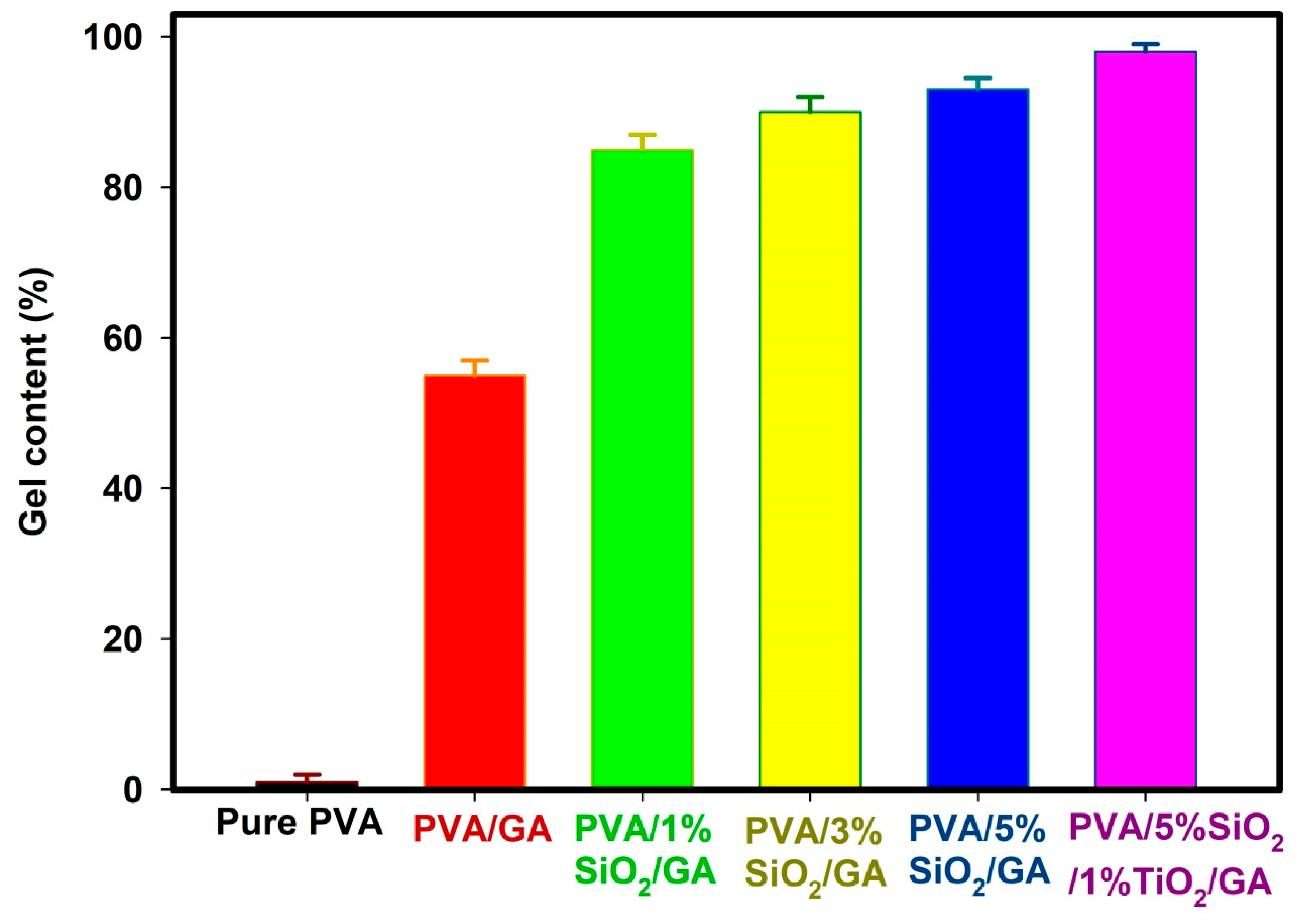
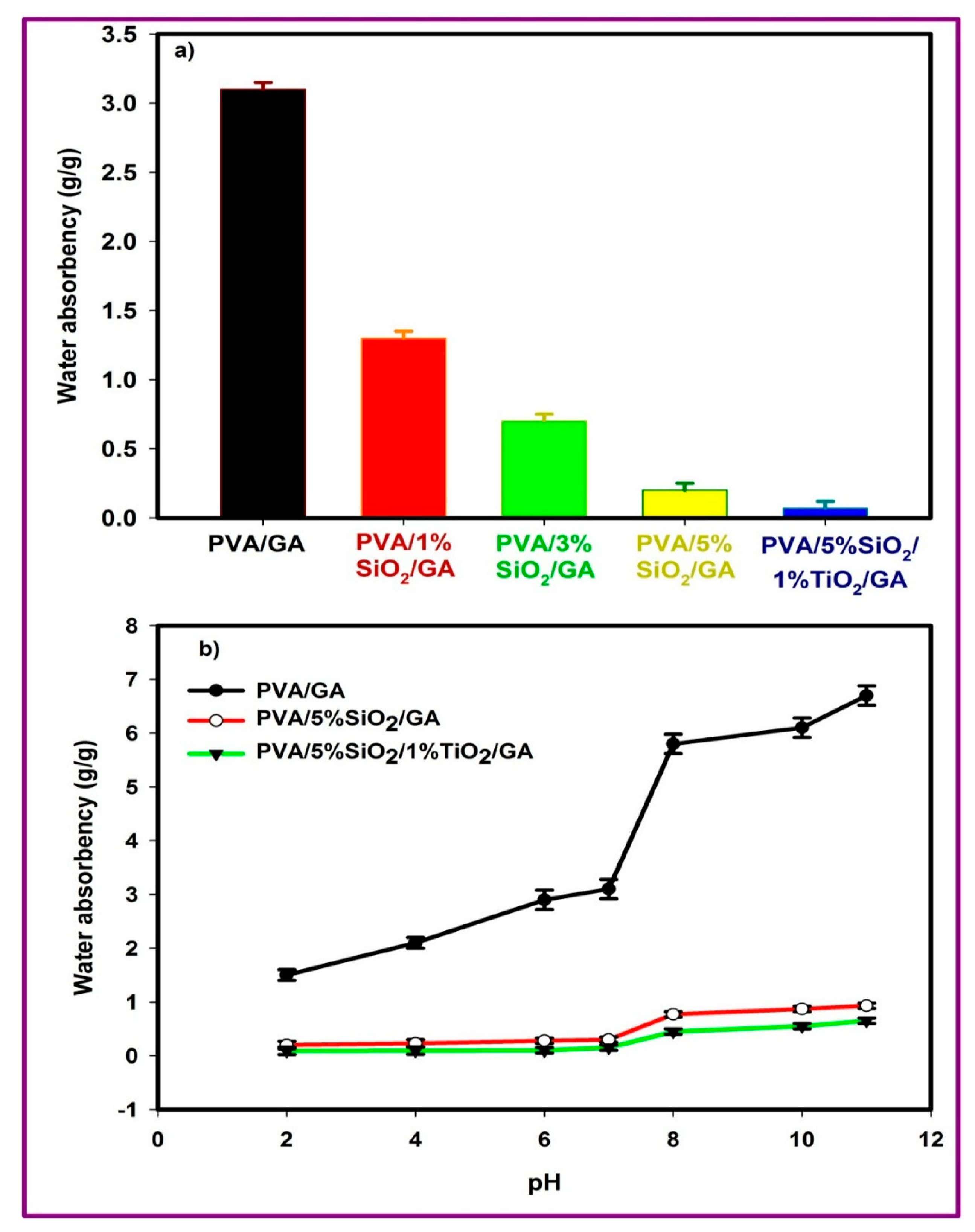
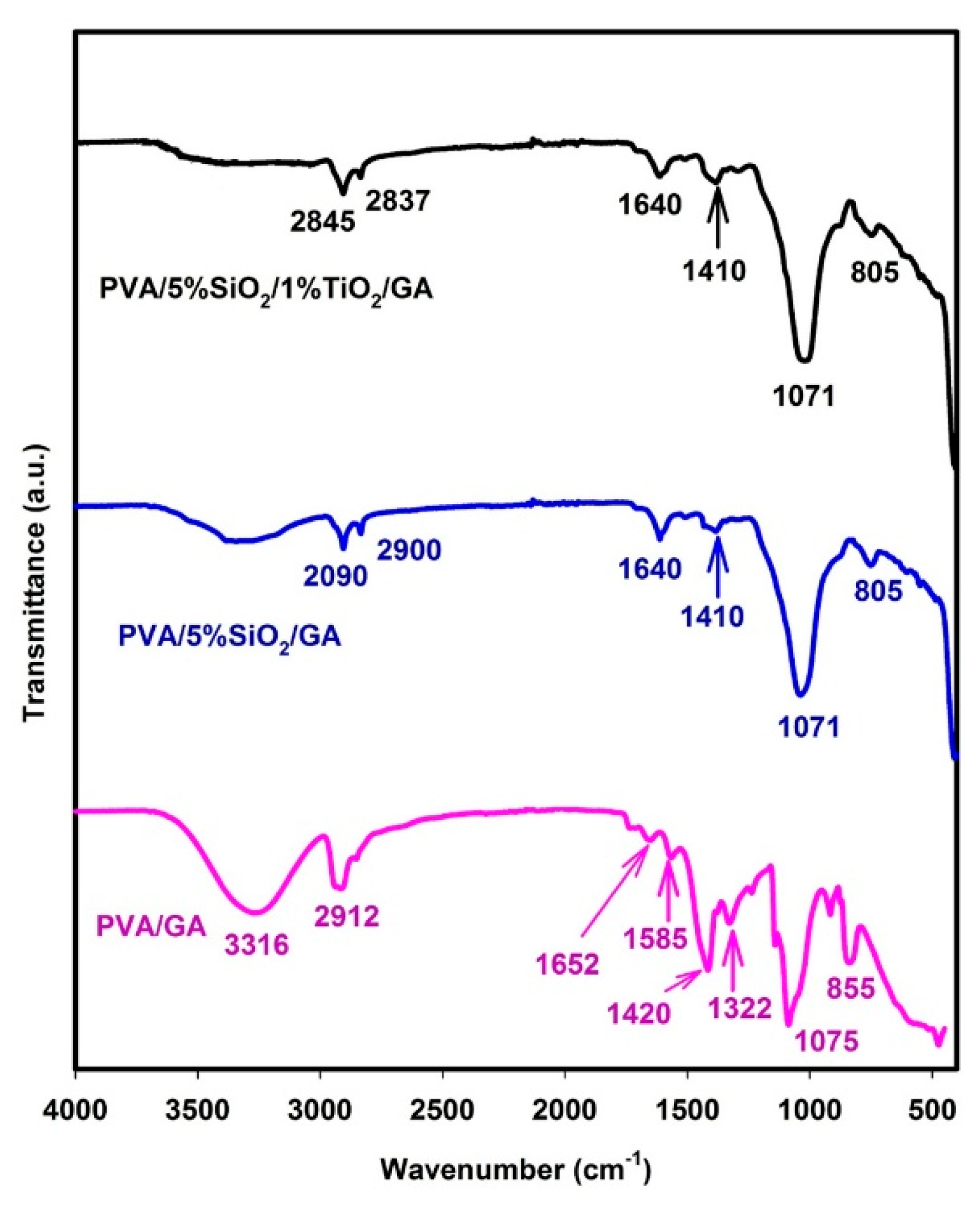
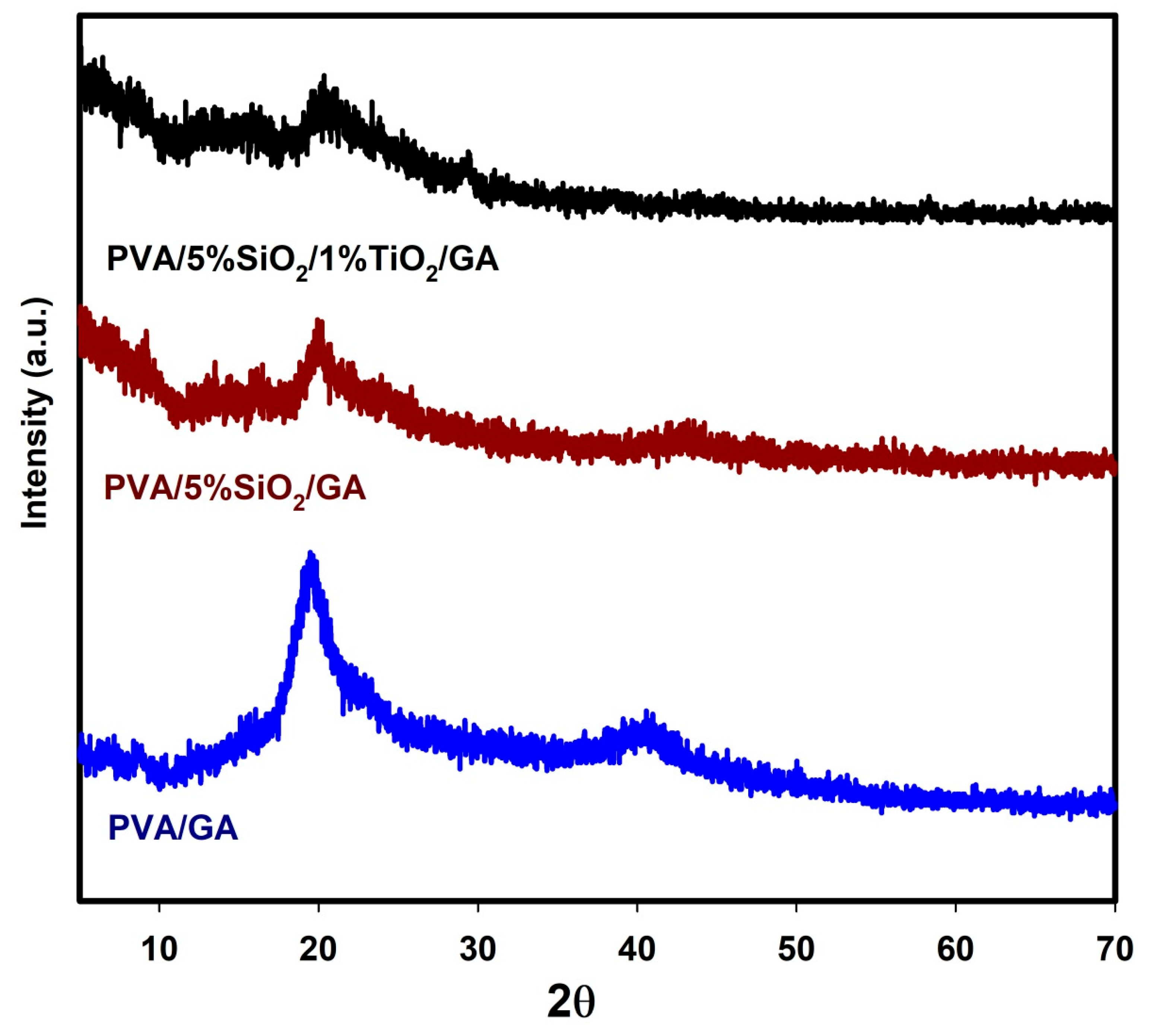
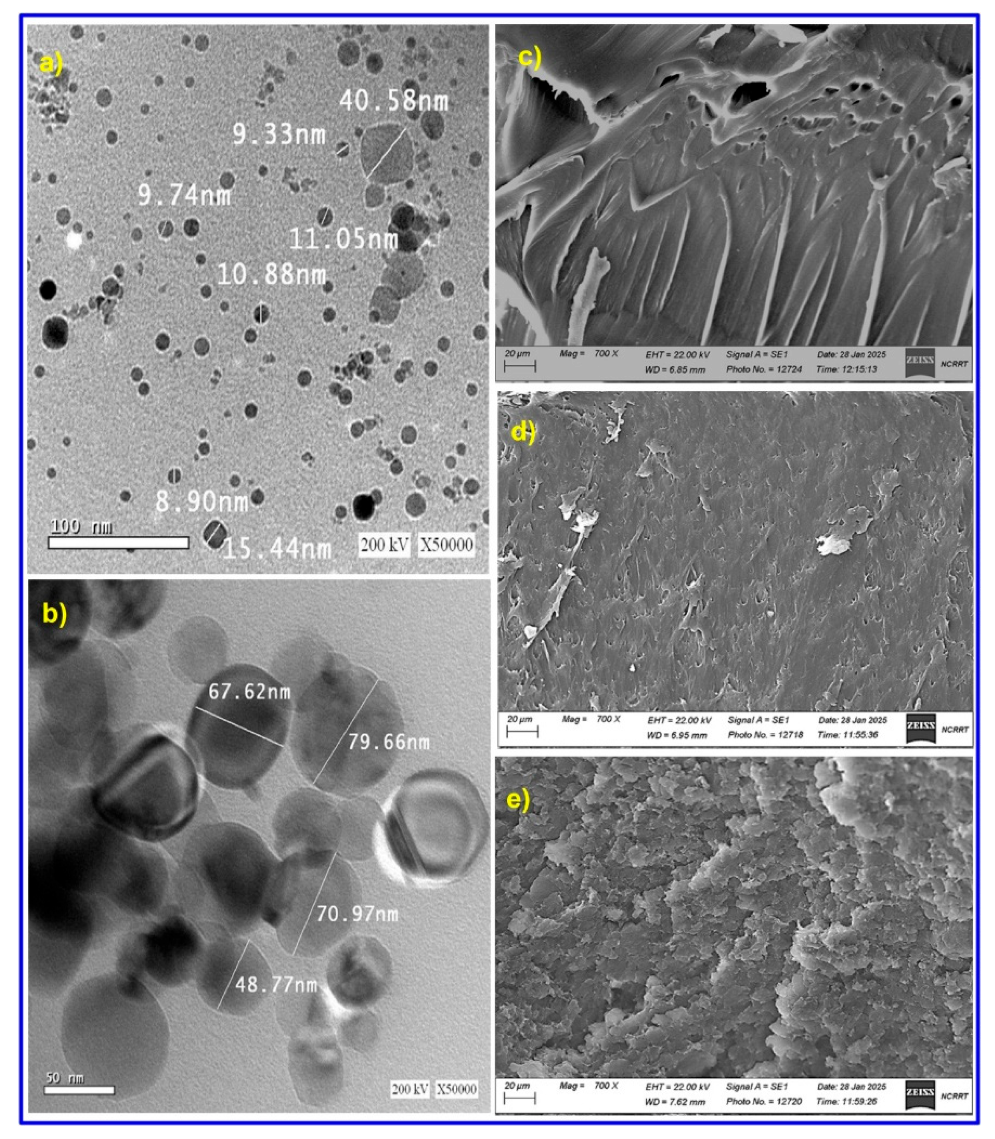
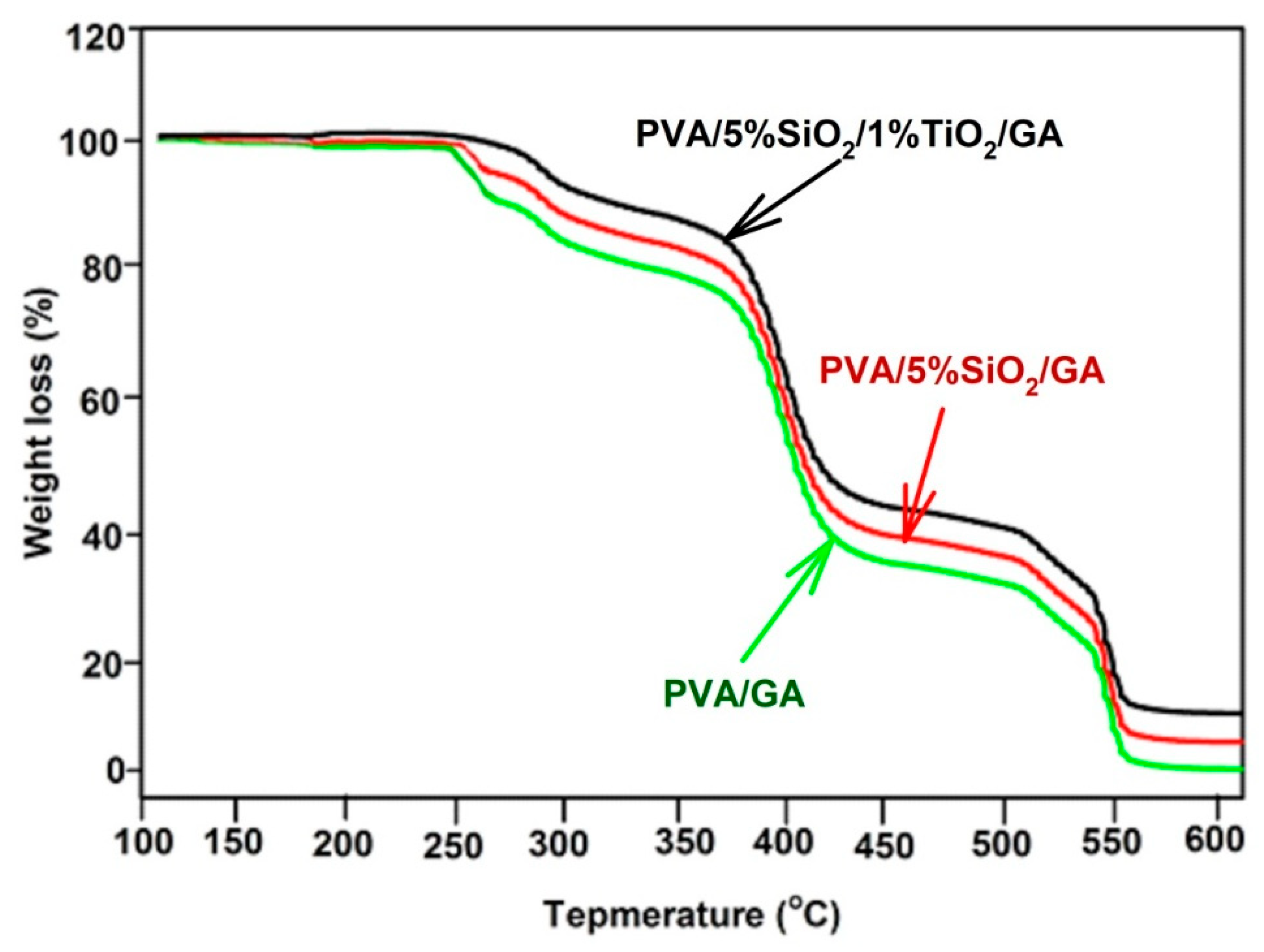
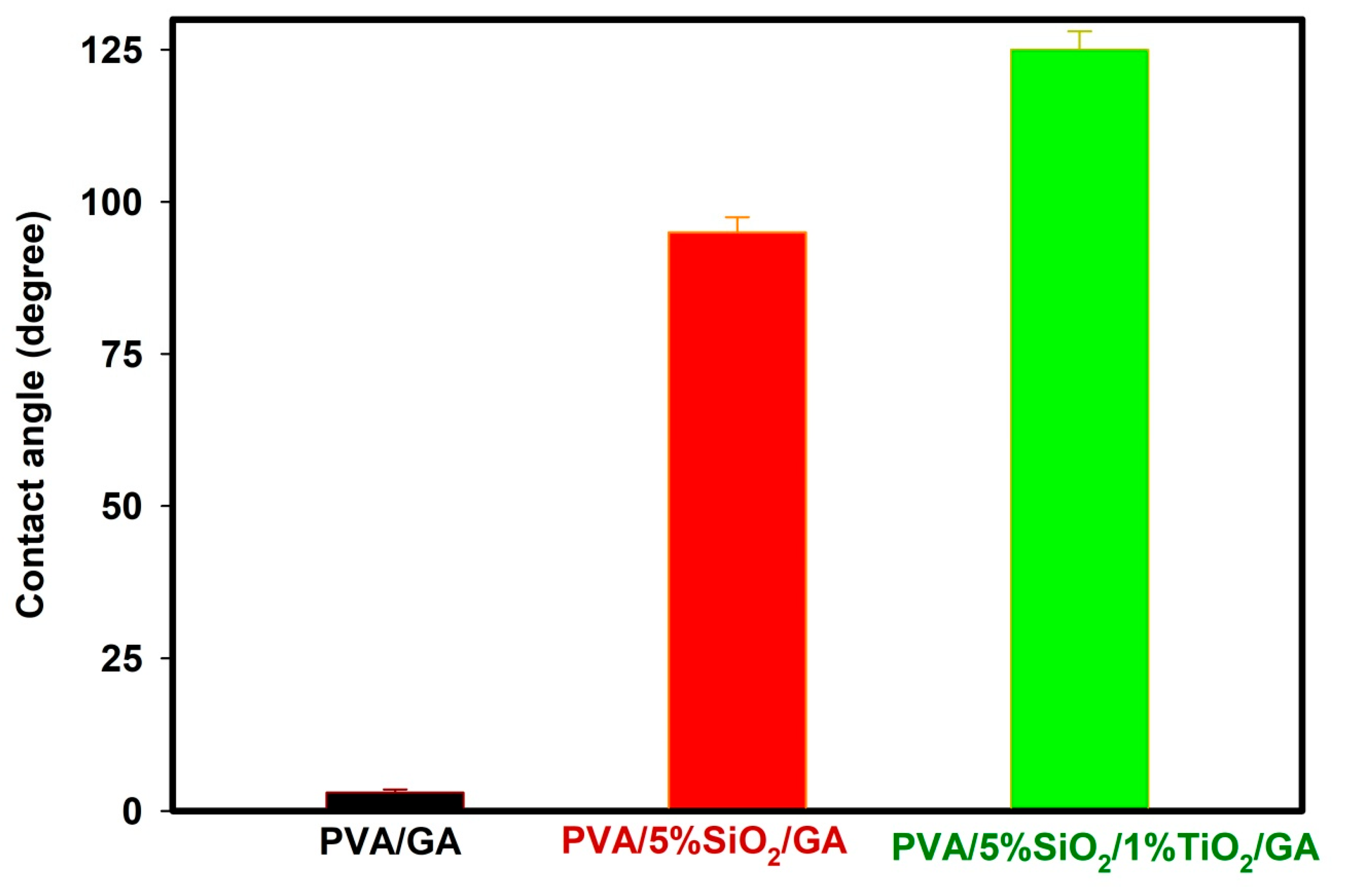
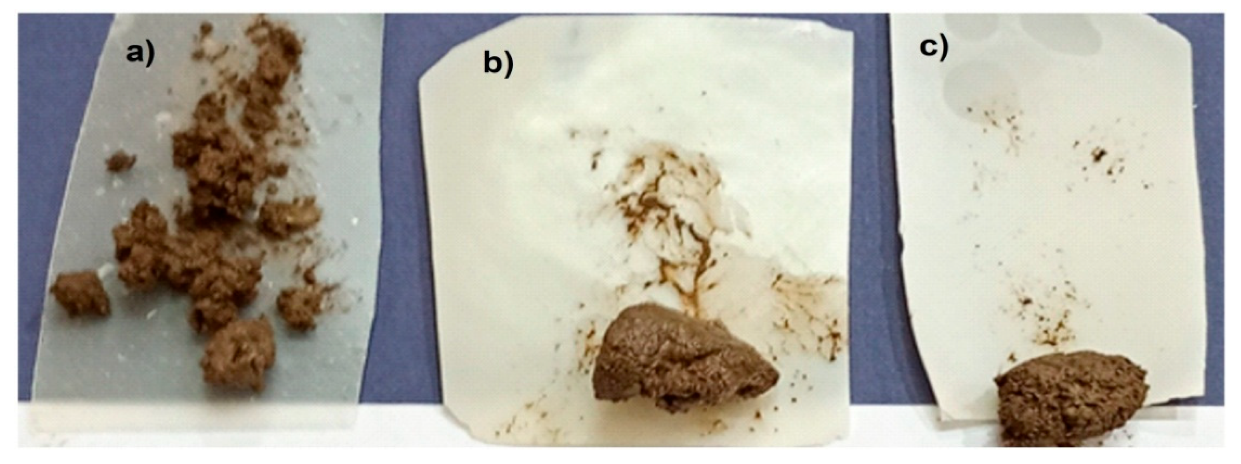

| Samples | Surface Hardness (Shore D) | Abrasion Test | Water Absorption (g/g) | Contact Angle (θ) | Loading on Compaction (at 200 Kg/cim 2) |
|---|---|---|---|---|---|
| PVA/GA/sand | 71 | 8 | 3.4 | 0 | 7% |
| PVA/5% SiO2/1% TiO2/GA/sand | 87 | 2 | 0.01 | 125 | 3% |
Disclaimer/Publisher’s Note: The statements, opinions and data contained in all publications are solely those of the individual author(s) and contributor(s) and not of MDPI and/or the editor(s). MDPI and/or the editor(s) disclaim responsibility for any injury to people or property resulting from any ideas, methods, instructions or products referred to in the content. |
© 2025 by the authors. Licensee MDPI, Basel, Switzerland. This article is an open access article distributed under the terms and conditions of the Creative Commons Attribution (CC BY) license (https://creativecommons.org/licenses/by/4.0/).
Share and Cite
Khedr, R.F.; Elhady, M.A. Development the Hydrophobic Property of Polyvinyl Alcohol/Silicon Dioxide/Titanium Dioxide Nanocomposites for Self-Cleaning and Soil Stabilization. Molecules 2025, 30, 1664. https://doi.org/10.3390/molecules30081664
Khedr RF, Elhady MA. Development the Hydrophobic Property of Polyvinyl Alcohol/Silicon Dioxide/Titanium Dioxide Nanocomposites for Self-Cleaning and Soil Stabilization. Molecules. 2025; 30(8):1664. https://doi.org/10.3390/molecules30081664
Chicago/Turabian StyleKhedr, Rania F., and Mohamed Abd Elhady. 2025. "Development the Hydrophobic Property of Polyvinyl Alcohol/Silicon Dioxide/Titanium Dioxide Nanocomposites for Self-Cleaning and Soil Stabilization" Molecules 30, no. 8: 1664. https://doi.org/10.3390/molecules30081664
APA StyleKhedr, R. F., & Elhady, M. A. (2025). Development the Hydrophobic Property of Polyvinyl Alcohol/Silicon Dioxide/Titanium Dioxide Nanocomposites for Self-Cleaning and Soil Stabilization. Molecules, 30(8), 1664. https://doi.org/10.3390/molecules30081664







